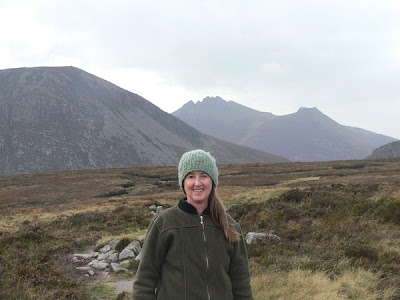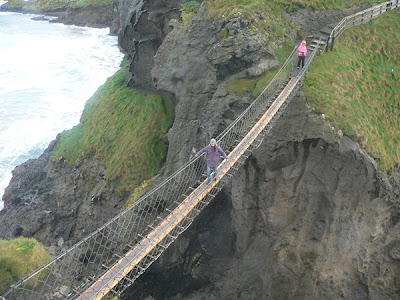Northern Ireland
Mourne Mountains
We crossed into Northern Ireland at County Down, where we had time to do an afternoon 'hill-walk' before continuing on to Belfast. The Mourne Mountains are jagged on top unlike most of Ireland's rounded hills, due to the presence of granite in these coastal mountains.
Belfast
We only spent one day and one night in Belfast, and found it to be a friendly, clean and fairly prosperous city, not unlike Dublin in a lot of ways. Our hostel was in the Queen's University area, so first we walked around a botanical garden and history museum near campus, then walked through the city to the renowned murals commemorating events from the Troubles, as well as murals in solidarity with other causes like American civil rights and the Palistinians.
The murals are in a Catholic working class neighborhood that borders the Protestant working class neighborhood. There's a huge wall topped with barbed wire between them, and the gates in the picture below can be used to close off the road and the sidewalk at night or during times of violence.
This is one of the few murals on the Protestant side, with the Red Hand of Ulster on the left. Creepy story about that symbol - supposedly the first boat of Englishman was landing in Northern Ireland (it's only 12 miles between the two islands here) and the captain announced that whoever was the first to touch the shore would own that land, so one greedy bastard cut off his hand and threw it onto the shore in order to be the first.
Glens of Antrim
We left Belfast and stopped for a walk in Glenariff, one of the nine Glens of Antrim that run from the mountains down to the sea.
The glen and waterfalls reminded me of a Finger Lakes gorge trail but with wooden boardwalks instead of stone.
Carrick-a-Rede Rope Bridge
The next morning we went to the Carrick-a-Rede rope bridge, which was originally constructed by fisherman so they could stand on it and drop nets for salmon, but now tourists pay a fiver and cross it for a thrill. Crossing the bridge is exciting enough on a calm day, but the day we were there tropical depression Ophelia had crossed the Atlantic and gale force winds were slamming into the Irish coast.
Bill crossed first while I got his photo, then I went across. Not too bad going over, just don't look down!
Meanwhile the winds were picking up. Bill crossed first. When he was halfway across the bridge the winds started gusting so hard his glasses started to blow right off his face! He stopped to take them off and shove them in his pocket, then crouched down and crossed the rest of the way quickly.
My turn to cross. I looked at the bridge bucking up and down and side-to-side. No way was I going across that. The bridge-keeper came out of his little shelter and motioned to me and the four others on the island to stay where we were. He kept checking the wind speed with a hand-held anemometer and shaking his head no. Finally the winds lessened briefly and the bridge-keeper was able to scurry across the bridge to where were were waiting on the island, and when there was a slight lessening of the wind he escorted each of us across one by one. Going across two at at a time was better - more weight to hold it down!
Once I was back on the mainland and the winds and my heart had calmed down I went back across the bridge one more time - for the photo opp!
The Giant's Causeway
A few miles further along the coast is the Giant's Causeway, one of Northern Ireland's top tourist attractions and a UNESCO World Heritage Site. The Causeway is a natural formation of basalt columns that are hexagonal in shape and stacked tightly together. The columns were formed 65 million years ago when there was intense volcanic activity in this region. The molten lava hit the sea water and cooled very quickly, and the columns were formed in much the same way that mud can develop symmetrical cracks as it's drying.
The columns descend to the sea like the ramp of some long-gone bridge. Legend claims that the giant Fionn MacCumhaill (Finn McCool) built the
Causeway from the North coast of Antrim as a pathway to the Scottish
island of Staffa (which can be seen on clear days) to confront his enemy Benandonner. The existence of
similar basalt columns at Fingal's Cave on the island reinforced belief
in the legend.
We walked along the coastal trail and came upon more basalt columns higher up. These were buried under another layer of rock that had been deposited on top of the columns, which you can see in this view looking straight up the columns.
And a little further along the trail, a completely different type of rock, so red and shiny it hardly looked real. A very interesting area geologically.
The gales from tropical depression Ophelia were still really intense. The winds funneled around this rock promontory creating a Bernoulli effect that lifted me right off my feet and into that fence, the only thing between me and a several hundred foot drop. Getting blown around is a chronic problem for me here: light frame + wind-resistant jacket = a kite!
This is a happy-to-be-alive smile. Chrys - 2, Ophelia - 0.
The next morning the storm had cleared to blue skies and lavender clouds, and we took a walk on another section of the Causeway Coastway with cool stone arches and rock formations.
This castle was built on a high rock outcropping and is only accessible by the stone bridge. What a great location for defense.
Strokestown Park House
After leaving beautiful Northern Ireland, we drove south to Strokestown, County Rosscommon for a traditional music festival. Bill's paternal grandmother's people were Cullens from County Rosscommon, and it's interesting that Rosscommon is known for flute players. Bill has been an avid flute player (classical and Irish music) for many years.
While in Strokestown we toured the house and gardens of Strokestown Park House, the former estate of a wealthy family that once owned 30,000 acres here. They were bad landlords, treating their tenants very poorly and forcing most of them into emigration, and as a result the landlord was assassinated in 1847 at the height of the Famine. The Irish National Famine Museum is now located in the stables of the house and tells of that terrible period with accuracy and sensitivity.
 The lady of the house was such a snob that she would walk along the galley at the upper right and drop down the menu for the day to the servants below, so she wouldn't have to make verbal, physical or even eye contact with them.
The lady of the house was such a snob that she would walk along the galley at the upper right and drop down the menu for the day to the servants below, so she wouldn't have to make verbal, physical or even eye contact with them.The last member of the family to live in the house had the old kitchen walled over and a modern 1950's kitchen installed. When a local man purchased the house in the 1980's to restore it, he was astonished and delighted to find the perfectly intact kitchen, including cooking pots and cauldrons, behind the false wall!
And no 18th century kitchen would be complete without a jar of leeches.
In the veg garden - glass houses for growing tropical fruits like peaches and pineapples.
These peach trees have been trained to grow almost horizontally on wires. Those are hot water pipes running underneath to provide heat - peach trees can grow outside here, but they need the heat to develop and ripen the fruits.

























































